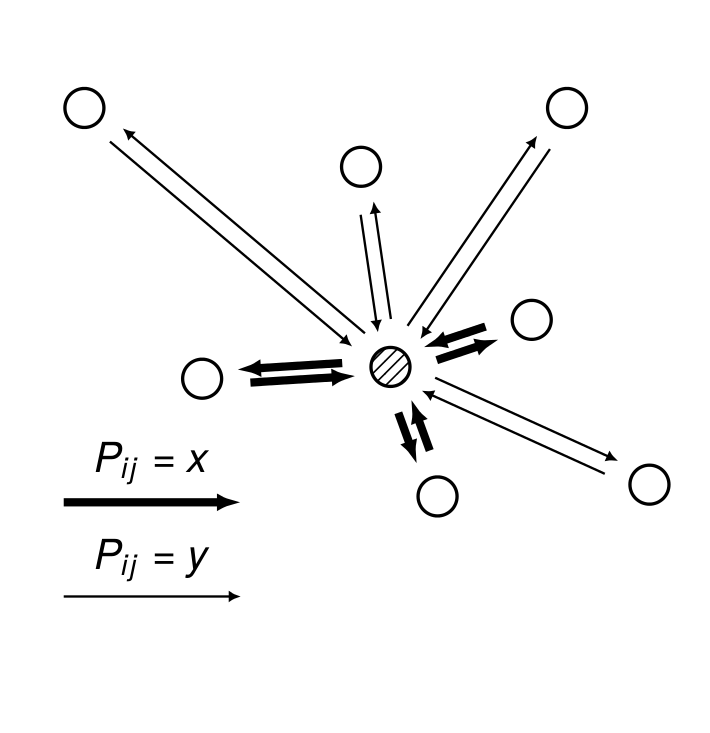Fig 1A
The illustration

was created with TikZ using the following LaTeX code
\documentclass{standalone} \usepackage{tikz} \usetikzlibrary{arrows.meta,decorations.pathmorphing, backgrounds,positioning,fit,matrix, decorations, patterns} \renewcommand{\familydefault}{\sfdefault} \usepackage{tgheros} \usepackage{sansmath} \usepackage{siunitx} \usepackage[english]{babel} \usepackage[utf8]{inputenc} \usepackage[T1]{fontenc} \begin{document} \begin{tikzpicture}[font=\sffamily\sansmath] \pgfmathsetmacro{\shift}{0.3ex} %%\node[circle,thick,draw=gray, dashed, minimum size=3.2cm] (src) at (0,0) {}; \node[draw,circle, thick, pattern=north east lines] (src) at (0,0) {}; %% \begin{scope}[every node/.style={circle,thick,draw, scale=1.}] %% \node (src) at (0,0) {}; %% \end{scope} \def\XR{2.6} \def\XL{3.2} \def\YU{3.} \def\YD{3.} \begin{scope}[every node/.style={}] \node (ur) at (\XR,\YU) {}; \node (dr) at (\XR,-\YD) {}; \node (dl) at (-\XL, -\YD) {}; \node (ul) at (-\XL, \YU) {}; \end{scope} \begin{scope}[every node/.style={circle,thick,draw, scale=1.}] \node (t1) at (1.2,.4) {}; \node (t2) at (.4,-1.1) {}; \node (t3) at (-1.6,-0.1) {}; \end{scope} \begin{scope}[every node/.style={circle,thick,draw, scale=1.}] \node (d1) at (1.5,2.2) {}; \node (d2) at (-2.6,2.2) {}; \node (d3) at (2.2,-1.) {}; \node (d4) at (-0.25,1.7) {}; \end{scope} %% Legend \def\Llen{-1.75} % length of arrows \def\Lytop{-1.05} % y-dist from top \def\Lxright{-0.3} %x-dist from right \def\Lysep{-.8} %y-dist between two arrows \begin{scope}[every node/.style={}] \node (lul) at (-\XL-\Llen-\Lxright,-\YD-\Lytop) {}; \node (lur) at (-\XL-\Lxright,-\YD-\Lytop) {}; \node (ldl) at (-\XL-\Llen-\Lxright,-\YD-\Lytop-\Lysep) {}; \node (ldr) at (-\XL-\Lxright,-\YD-\Lytop-\Lysep) {}; \end{scope} \begin{scope}[every path/.style={-{Latex[length=2mm]}, draw, solid, line width =0.7mm, shorten <= 5pt, shorten >=5pt}] \pgfmathsetmacro{\shift}{0.3ex} \path [transform canvas={xshift=\shift,yshift=-\shift}] (src) -- (t1); \path [transform canvas={xshift=-\shift,yshift=\shift}] (t1) -- (src); \path [transform canvas={xshift=-\shift,yshift=-\shift}] (src) -- (t2); \path [transform canvas={xshift=\shift,yshift= \shift}] (t2) -- (src); \path [transform canvas={xshift=-\shift,yshift= \shift}] (src) -- (t3); \path [transform canvas={xshift=\shift,yshift=-\shift}] (t3) -- (src); \path [shorten <= 0pt, shorten >= 0pt] (ldr) -- node[above]{$P_{ij}=x$} (ldl); \end{scope} \begin{scope}[every path/.style={-{Latex[length=1mm, width=1mm]}, draw, solid, line width = 0.2mm, shorten <= 5pt, shorten >=5pt}] \path [transform canvas={xshift=-\shift,yshift= \shift}] (src) -- (d1); \path [transform canvas={xshift= \shift,yshift=-\shift}] (d1) -- (src); \path [transform canvas={xshift= \shift,yshift= \shift}] (src) -- (d2); \path [transform canvas={xshift=-\shift,yshift=-\shift}] (d2) -- (src); \path [transform canvas={xshift= \shift,yshift= \shift}] (src) -- (d3); \path [transform canvas={xshift=-\shift,yshift=-\shift}] (d3) -- (src); \path [transform canvas={xshift= \shift,yshift= \shift}] (src) -- (d4); \path [transform canvas={xshift=-\shift,yshift=-\shift}] (d4) -- (src); \path [shorten <= 0pt, shorten >= 0pt] (lur) --node[above]{$P_{ij} = y$} (lul); \end{scope} \end{tikzpicture} \end{document}